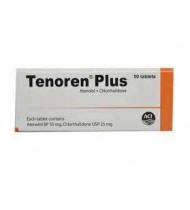Atenolol + Chlorthalidone
Indications
Atenolol & Chlorthalidoneis combination is indicated for the treatment of hypertension.
Pharmacology
Atenolol is a beta1-selective (cardio selective) beta-adrenergic receptor blocking agentwithout membrane stabilizing or intrinsic sympathomimetic (partial agonist) activities.This preferential effect is not absolute, however, and at higher doses, Atenolol inhibitsbeta-2-adrenoreceptors, chiefly located in the bronchial and vascular musculature.Chlorthalidone
Chlorthalidone is a monosulfonamyl double ring system which differs chemically fromthiazide diuretics in that a double ring system is incorporated in its' structure. It is an oraldiuretic with prolonged action and low toxicity. The diuretic of the drug occurs within 2 hours of an oral dose. It produces diuresis with greatly increased excretion of sodium andchloride. At maximal therapeutic dosage, Chlorthalidone is approximately equal in itsdiuretic effect to comparable maximal therapeutic doses of benzothiadiazine diuretics.The site of action appears to be the cortical diluting segment of the ascending limb of Henle's loop of the nephron.
Chlorthalidone is a monosulfonamyl double ring system which differs chemically fromthiazide diuretics in that a double ring system is incorporated in its' structure. It is an oraldiuretic with prolonged action and low toxicity. The diuretic of the drug occurs within 2 hours of an oral dose. It produces diuresis with greatly increased excretion of sodium andchloride. At maximal therapeutic dosage, Chlorthalidone is approximately equal in itsdiuretic effect to comparable maximal therapeutic doses of benzothiadiazine diuretics.The site of action appears to be the cortical diluting segment of the ascending limb of Henle's loop of the nephron.
Dosage & Administration
Chlorthalidone is usually given at a dose of 25 mg daily; the usual initial dose of Atenolol is 50 mg daily. Therefore, the initial dose should be one Chlorthalidone 25 & Atenolol 50 mg once a day. If an optimal response is not achieved, the dosage should be increased to one Chlorthalidone 25 & Atenolol 100 mg once a day. Dose of two tablets once daily should not be used as initial therapy in elderly patients.
Interaction
Atenolol and Chlorthalidone combination may potentiate the action of other antihypertensives such as Clonidine, Diltiazem. Prostaglandin synthase inhibiting drugs e.g. Indomethacin may decrease the hypotensive effects of beta-blockers. This tablet should not be given with Lithium due to high risk of Lithium toxicity.
Contraindications
Atenolol and Chlorthalidone combination is contraindicated in hypersensitivity to this product or to sulfonamide-derived drugs. It is also contraindicated in patients with sinus bradycardia, heart block greater than first degree, cardiogenic shock, overt cardiac failure and anuria.
Side Effects
Atenolol and Chlorthalidone combination is usually well tolerated. Most adverse effects have been mild and transient. However dizziness, fatigue, vertigo, nausea, diarrhea and bradycardia have been reported rarely.
Pregnancy & Lactation
Pregnancy Category D. Atenolol & Chlorthalidone combination can cause fetal harm to the developing baby and may appear in breast milk. So it should not be taken during pregnancy & lactation.
Precautions & Warnings
Atenolol and Chlorthalidone combination should be given with caution to patients with severe renal impairment, uncontrolled heart failure, impaired hepatic function or liver disease.
Use in Special Populations
Pediatric Uses: Safety and effectiveness in pediatric patients have not been established
Use in elderly: Clinical studies of Atenolol & Chlorthalidone combination did not include sufficient numbers of subjects aged 65 and over to determine whether they respond differently from younger subjects.
Use in elderly: Clinical studies of Atenolol & Chlorthalidone combination did not include sufficient numbers of subjects aged 65 and over to determine whether they respond differently from younger subjects.
Overdose Effects
No specific information is available with regard to over dosage and Atenolol and Chlorthalidone in humans. Treatment should be symptomatic and supportive and directed to the removal of any unabsorbed drug by induced emesis, or administration of activated charcoal. Atenolol can be removed from the general circulation by hemodialysis. Further consideration should be given to dehydration, electrolyte imbalance and hypotension by established procedures.
Therapeutic Class
Combined antihypertensive preparations
Storage Conditions
Store in cool and dry place, protected from light.
Tenoren Plus Tablet 50 mg+25 mg
IndicationsAtenolol & Chlorthalidoneis combination is indicated for the treatment of hypertensio..
3.02Tk.
Showing 1 to 1 of 1 (1 Pages)

